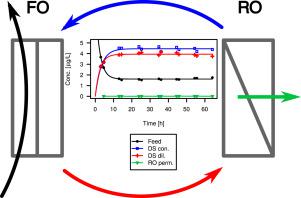Journal of Membrane Science ( IF 9.5 ) Pub Date : 2021-02-15 , DOI: 10.1016/j.memsci.2021.119182 Arnout D’Haese , Juan Carlos Ortega Bravo , Danny Harmsen , Lynn Vanhaecke , Arne R.D. Verliefde , David Jeison , Emile R. Cornelissen

|
Long-term operation of a forward osmosis – reverse osmosis (FO–RO) closed loop pilot plant is presented. The system was fed with a single batch of clean tap water into which organic micropollutants were spiked; RO permeate was recirculated to the FO feed. The system was operated in two different runs, with NaCl and MgCl2 as draw solutes. Over the course of the pilot plant trials, the organic micropollutants migrated into the draw solution closed-loop, reaching an equilibrium with the FO feed. This implies that there was strong accumulation of the organic micropollutants in the draw solution, up to a factor of 50 relative to the FO feed. FO rejection was variable between 55 and 91% for the different micropollutants, while RO rejection was high in all cases: in excess of 99% for all but one organic micropollutant. The extent of micropollutant accumulation in the draw solution was related to high RO selectivity and internal concentration polarization within the FO membrane’s support layer. In turn, FO permeability and the extent of accumulation were found to correlate negatively: well-rejected compounds accumulated slower in the draw solution loop, but to a higher extent. The FO membrane’s structural parameter, as obtained from clean water flux tests using mineral salt draw solutes, was a poor predictor of organic micropollutant internal concentration polarization.
中文翻译:

分析闭环FO-RO系统中的有机微量污染物累积:工厂试点研究
介绍了正渗透-反渗透(FO-RO)闭环中试装置的长期运行。向系统中注入单批清洁的自来水,在其中加入有机微量污染物。RO渗透物再循环到FO进料中。该系统使用NaCl和MgCl 2进行了两种不同的运行作为吸引溶质。在中试工厂的过程中,有机微量污染物闭环迁移到汲取溶液中,并与FO进料达到平衡。这意味着在抽提溶液中有机微量污染物有很强的积累,相对于FO进料最多可达50倍。对于不同的微污染物,FO排斥率在55%到91%之间变化,而在所有情况下RO排斥率都很高:除一种有机微污染物外,所有其他污染物的RO排斥率都超过99%。汲取溶液中微污染物的积累程度与FO膜支撑层内的高RO选择性和内部浓度极化有关。反过来,发现FO渗透率和积累程度呈负相关:被排斥的化合物在汲取溶液回路中的积累较慢,但程度更高。FO膜的结构参数(从使用矿物盐抽吸溶质的净水通量测试获得)不能很好地预测有机微污染物内部浓度的极化。


























 京公网安备 11010802027423号
京公网安备 11010802027423号